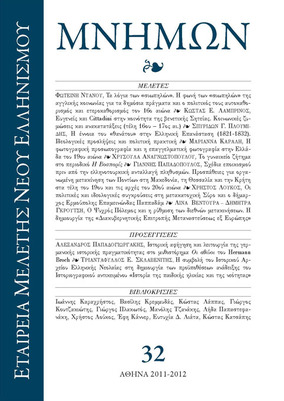Οι αιρέσιμοι πολίτες : ποσοτική προσέγγιση της κοινωνικής διαστρωμάτωσης στην Ελλάδα του 1860
Part of : Μνήμων ; Vol.18, 1996, pages 23-60
Issue:
Pages:
23-60
Parallel Title:
The Eligible Citizens : Λ quantitative approach of social stratification in Greece in the year 186
Section Title:
Articles
Abstract:
In the years 1830-1860 the formation of the newly established Greek State was based theoretically and practically on the political views of 19th century European liberalism. In accordance to the liberal beliefs, the Greek state political power was based on a small section of the adult male population. This section disposed additional economic and cultural qualifications compared to the rest of the population of the country. It is worthnoting that only to the above mentioned section of the population the state recognized full civil and political rights. In this context the term eligible citizens is used to describe those social strata which held the above mentioned special qualifications. In view of these qualifications the eligible citizens could not only exercise their electoral rights but they could be also elected or appointed as political, magisterial or administrative officials. Within the framework of the historical study of social stratification in the Greek society, during the period 1830-1860, it is worth concentrating on the analysis of historical sources relevant to the eligible citizens. These sources should supply information about the economic and cultural characteristics of these citizens. Based on this type of approach we present in this study the catalogues of candidate jurymen in the period 1849-1861 concentrating on the analysis of the year 1860. These catalogues constitute an important source of information about the characteristics of the eligible citizens. The candidate jurymen catalogues, for the year 1860, include information regarding the value of estate property, income, profession, age and place of inhabitancy for 8.337 adult men. These men amount to the 3.4% of the over 25 years old male population of the country in 1860. The quantitative analysis of the above mentioned catalogues led to the following general conclusions: In 1860 the greatest percentage of the eligible citizens derived from the middle social strata of property owners and income earners. These strata included mainly land owners, wealthy farmers and merchants. But there was also a much smaller section of social strata of wealthy men who possessed a relatively large amount of estate property and income of the country. The sharp economic inequality observed among the eligible citizens of the country permits the assumption that there was also among them a sharp social inequality. According to this we propose the continuation of the research with a more detailled study. This study will examine particular aspects of economic and social inequalities between the lower, the middle and the higher social strata. The same study will also examine in detail the regional aspect of these inequalities.
Subject:
Subject (LC):




